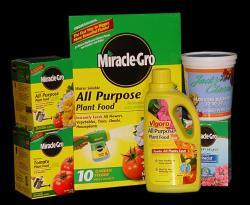Usually, a growing medium that contains no fertilizer, or very little, is recommended for this purpose. That’s because new seedlings are baby plants and it doesn’t take much nitrogen to burn their delicate roots.
The seedlings won’t actually need any fertilizer until they start developing their first true leaves. That’s because the cotyledons (seed leaves) contain the stored food reserves of the seed. However, as these reserves are used up, the true leaves will need to be nourished. You’ll want to use a liquid or water-soluble powdered fertilizer for this purpose.
Maybe you have read that you should apply fertilizer to seedlings at a certain fractional rate, such as one-half or one-fourth the recommended strength. The problem with that method is that it depends too much on the strength of the fertilizer to start with. For example, at this time I happen to have three different boxes of soluble fertilizers, all by Miracle-Gro. The analysis on the label of each box is different. One shows 18-18-21, one shows 24-8-16 and one shows 30-10-10. Yet, on all three boxes the recommended dosage is the same (one tablespoon per gallon of water).
Regardless of the fractional rate you decide to use, the strength of the nitrogen will be different for all three of the abovementioned fertilizers. In my opinion, there is little logic and no consistency in using such a method. The best and safest way to fertilize your young seedlings is to use the PPM (parts per million) method. That method takes into account the percentage of nitrogen in your fertilizer, and the results will always be logical and consistent.
PPM can be calculated mathematically. However, you can save yourself a lot of trouble by using a PPM calculator. PPM calculators, as well as simplified dosage guides, can often be found on-line. One such calculator can be found on the First Rays LLC site By Clicking Here. Although it focuses primarily on orchids, the information found on that site will be helpful regardless of what you’re growing.
There is no ideal fertilizer or nutrient solution for all plants. It just depends on the type of plant, the stage of plant development, the season of the year, and environmental conditions. A web search is often helpful when you have questions about how many ppm you should use for your particular seedings. If you’re unsure, try starting by feeding about 50 ppm (based on the nitrogen percentage of the fertilizer) once a week. The dosage should be increased as the plants develop more leaves. 100 ppm and 150 ppm are common until the plants are transplanted into a growing mix that contains its own fertilizer. If the plants appear to need more, go for 200 ppm.
Technically, ppm is a ratio between two numbers that have the same units. However, research has proven that whether you’re using a liquid or a powdered water-soluble fertilizer, using ppm is far more accurate than the fractional rate method mentioned above.
In conclusion, let me encourage you to learn about and use the ppm method of fertilizing your seedlings. Your seedlings will be happier and healthier. You’ll be happier too, knowing that you’re doing the right thing.

| Thread Title | Last Reply | Replies |
|---|---|---|
| Broken link by antsinmypants | Apr 21, 2024 10:16 PM | 4 |
| A note on fertilizer strengths and seed starting by BetNC | Jul 7, 2016 12:18 AM | 9 |
| This is a very helpful article by Growgirl | Jul 4, 2016 7:18 PM | 5 |
| Calculating ppm mathematically by ArtD | Jun 26, 2016 11:25 AM | 0 |